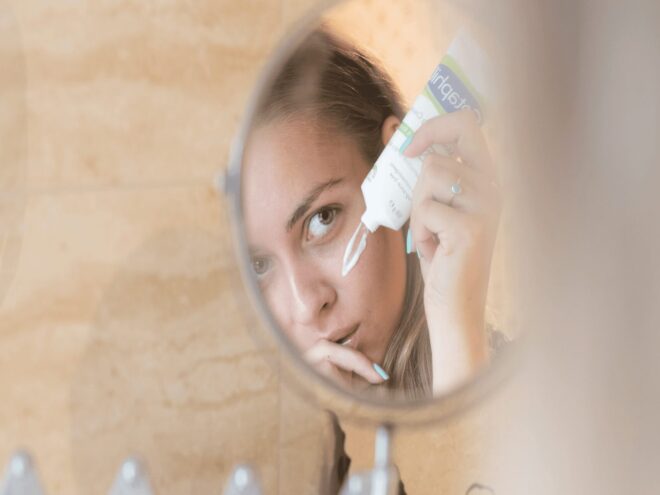Wellness • 01/06/2024
Does Retinol Make Your Skin Peel?: Understanding Skincare

Revivalist is a reader-supported endeavor and our posts may contain affiliate links. When you buy through links on our site, we may earn an affiliate commission.
Retinol is currently one of the most popular skincare trends, as seen all over social media. It’s renowned for its ability to promote a more youthful complexion. However, for many individuals starting with retinol or increasing its concentration, the skin peeling often accompanying it can be a surprising and unwelcome effect. But why does retinol make your skin peel?
What Is Retinol?
Retinol, a derivative of vitamin A, is a widely used skincare ingredient known for its skin-renewing properties. It works by accelerating skin cell turnover, encouraging the production of new skin cells while shedding old ones. This process helps improve skin texture, reduce fine lines and even out skin tone. However, it can cause skin sensitivity and dryness, especially when starting its use.
Why Does Retinol Make Your Skin Peel?
Retinol is widely celebrated for its ability to accelerate skin cell turnover. This skincare product has gone viral thanks to beauty gurus and social media tutorials. You may have succumbed to this trend, but now find it makes your skin peel. This unpleasant side effect is a result of the rejuvenation process.
It works by binding to specific receptors in the skin, stimulating the production of new skin cells and increasing the rate at which these cells migrate to the surface. This process encourages the shedding of older, dead skin cells, unveiling fresh, more youthful-looking skin underneath.
The skin peeling associated with retinol results from this increased cellular turnover. As the old skin cells are shed more rapidly than usual, the outermost layer of the skin can become dry and flaky, leading to visible peeling or flaking.

The following may be a cause of peeling:
- Accelerated exfoliation: Retinol effectively speeds up the skin’s exfoliation process. This shedding of dead skin cells can sometimes manifest as peeling, especially in the initial stages of retinol use or when transitioning to a higher concentration.
- Skin barrier adjustment: Retinol, particularly when introduced for the first time or in increased concentrations, might temporarily compromise the skin’s barrier. As the skin adapts to this potent ingredient, it can become more sensitive and prone to dryness, leading to flaking or peeling.
How to Add Retinol to Your Skincare Routine
The timing and regularity of retinol in your skincare routine can drastically impact its effectiveness and how well your skin tolerates it. Here’s a general guide on when to use it:
- Nighttime application: You should typically use retinol in the evening as it can make the skin more sensitive to sunlight. Apply it at night as part of your bedtime routine.
Start slowly: When introducing retinol to your routine, start slowly. Begin by using it 1-2 times a week to allow your skin to adjust. Over time, you can gradually increase the frequency, depending on how well your skin tolerates it. - Cleanse first: Begin by cleansing your face to remove dirt, makeup and any impurities. Ensure your skin is completely dry before applying retinol. Wait a few minutes after cleansing to allow your skin to fully dry.
- Pea-sized amount: Use a pea-sized amount of retinol for your entire face. Less is more and using too much could lead to irritation. Dab small amounts on different areas of your face and blend it in gently.
- Allow absorption time: Let the retinol absorb into your skin before applying any other products, such as moisturizers or night cream. It could take around 10-20 minutes for proper absorption.
- Follow with moisturizer: Once your skin has absorbed the retinol, follow up with a moisturizer to mitigate dryness or potential irritation. Moisturizing can lock in the retinol and provide added hydration.
- Use SPF during the day: Because retinol can increase sensitivity to the sun, it’s crucial to use sunscreen during the day when using retinol. Protecting your skin from harmful UV rays is essential to prevent damage and maintain the benefits of retinol.

Tips for Managing Peeling Caused by Retinol
To prevent or manage peeling as a result of retinol use, there are some basic measures you can take:
- Start slowly: Begin with a lower concentration of retinol and gradually increase usage as your skin adjusts. Gradual use helps reduce the intensity of peeling and allows your skin to acclimate to the ingredients.
- Focus on hydration: Keep your skin well-hydrated using a moisturizer that suits your skin type. Look for products containing ingredients like hyaluronic acid or ceramides that help retain moisture and support the skin barrier.
- Use sunscreen: Retinol can make the skin more sensitive to the sun. Wearing sunscreen daily helps protect the skin and prevents further damage, allowing it to heal and regenerate effectively.
- Consider buffering: Mix retinol with a moisturizer to lessen its strength, especially when first starting. Buffering can reduce the chances of intense peeling while still reaping the benefits of retinol.
- Be patient: Peeling is often a transient phase as your skin adapts to retinol. Be patient, as over time, the peeling tends to decrease as your skin acclimates to the treatment.
Best Retinol Products to Try
If you have very sensitive skin, you should consult a dermatologist before trying retinol products. However, if you want to try retinol and don’t typically have severe reactions to skincare products, here are some gentle options to try:
- CeraVe Skin Renewing Retinol Serum
- Versed Press Restart Gentle Retinol Serum
- Good Molecules Gentle Retinol Cream
Start by applying small amounts to your skin once a week. If you don’t see any irritation, you can try increasing to a few times a week.
When to Stop Using Retinol
Deciding when to stop using retinol can depend on various factors, including individual skin tolerance, goals and concerns. However, there are several situations when one might consider discontinuing or pausing the use of retinol:
- Severe irritation: If you experience severe or persistent irritation, redness, extreme dryness or excessive peeling that doesn’t improve with adjustments in frequency of concentration, it might be advisable to stop using retinol temporarily. These symptoms could indicate that your skin is overly sensitive to the ingredient or that you use it too frequently or at too high a concentration.
- Pregnancy or breastfeeding: Health care professionals generally recommend avoiding retinol if you’re pregnant or nursing. Retinol contains high levels of vitamin A, which can potentially adversely affect the baby.
- Achievement of desired results: Once you’ve reached your skincare goals, such as improved texture, reduced fine lines or enhanced skin tone, you might choose to decrease the frequency or discontinue retinol use altogether. It’s not always necessary to continue using it if you’re satisfied with the results.
- Seasonal adjustments: Some people find their skin reactions differently to retinol in different seasons. If you notice increased sensitivity or excessive dryness during colder, drier months, you might consider reducing the frequency of discontinuing use temporarily until the weather becomes more favorable for your skin.
- Switching to maintenance: After an initial phase of using retinol for its skin-renewing benefits, you might opt to switch to a maintenance routine. A maintenance routine might involve using retinol less frequently or substituting it with gentler skincare ingredients while still maintaining the results.

Renew Your Skin Without the Peeling
If you’ve ever wondered, “Why does retinol make your skin peel?” It’s because it’s a potent ingredient that works to renew and rejuvenate the skin. While you can expect this to be part of the process, it’s essential to approach retinol use gradually and cautiously, and use proper skin care practices to minimize the peeling and maximize the benefits.
Subscribe to Our Weekly Newsletter
We would love to connect deeper with you!


